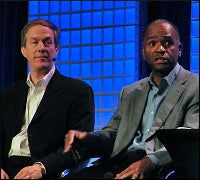 |
| Riverbed’s Mark Day (left) and Cisco’s Paul McNabb Photo: Sean Michael Kerner |
LAS VEGAS — What does the future hold for datacenter networking? According to a panel of executives from leading networking vendors, it’s a future that will need standards, that will take time to develop and deploy.
Mark Day, chief scientist at Riverbed, Paul McNabb, vice president of Enterprise & Mid-Market Solutions marketing at Cisco, Dave Stevens, CTO at Brocade, and David Yen, executive vice president and general manager at Juniper Networks, took the stage in a keynote panel event at the Interop conference today. For the most part, the vendors agreed on the where datacenter networking is going, though the path to get there is not as certain.
“We’ve seen a major change in networking in the last several years and there is now a clear need for a far more integrated offering than the standalone silos that have existed for much of the last 15 years,” Cisco’s McNabb said.
Brocade’s Stevens agreed with McNabb and added that in his view integration need to get tighter but not in by doing a vertical integration from one vendor, which could lead to vendor lock-in.
“The datacenter has to be open,” Stevens said. “We’re adamant that interfaces are standards based and you can incorporate infrastructure that is already there and from other leading IT players.”
The Role of Standards
While all the vendors on the panel agreed that standards are a good thing and are needed, there was some discussion as to when a vendor should deploy pre-standard technologies.
Stevens stated that a case could be made for a vendor to innovate their technology ahead of a formal standard.
“The question for users is, will the innovation end up being a standard and end up enabling choice,” Stevens said.
Riverbed’s Day argued that sometimes standards efforts start too early in the lifecycle of a new technology. In his view what happens in those cases is people don’t realized yet what matters and what doesn’t.
“There is something to be said for offering customers sustainable differentiation,” Cisco’s McNabb said. “It .has to be a balance and we do need to improve interoperability.”
What New Standards are Needed?
Brocade’s Stevens made a case for a need around standards for virtual machine mobility and transport and assurance for quality of service. Today there are competing technologies for monitoring and maintaining quality of service.
Juniper’s Yen agreed and added that the network access layer is now blurry between hardware and software virtualization.
While standardization is a good thing to have, Cisco’s McNabb said that it would likely take a year to two years to standardize that effort, but for now companies need to have competitive differentiation to offer customers on virtualization.
McNabb said that customers have a need now for virtualization mobility and while standards evolve there will likely be some grandstanding by vendors.
What Should Datacenter do in this economy?
All of the panel vendors agreed that consolidation is a key to helping datacenters deal with the current state of the economy. Juniper’s Yen noted that virtualization for network, storage and server assets are a key part of that.
Cisco’s McNabb added that consolidation to newer platforms that have better power utilization is important and can yield cost savings.
Part of the consolidation strategy for the economy is also about consolidating networking assets in a central location and putting less gear into a branch office.
“Centralize where you can and distribute where you must,” Yen said.


